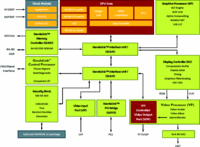AMD adds 32-, 64-bit embedded processors
Feb 12, 2007 — by LinuxDevices Staff — from the LinuxDevices Archive — 27 viewsAMD has introduced several new versions of its Geode LX processor, and has added a “low power” version of its 35-Watt dual-core Athlon 64 X2 to its embedded roadmap. Additionally, the company is offering three new reference designs, including an ATCA blade, a SOHO NAS server, and an “ultra-value client.”
AMD's slew of embedded processor news announcements were timed to coincide with the opening of the Embedded World Exhibition & Conference in Germany on Feb. 12.
New Geode LX models
AMD has added two new models to its Geode LX SoC (system-on-chip) family, which previously consisted only of the 500MHz [email protected] part. The new Geode [email protected] model runs at a slightly higher voltage — and consumes a little more power — while the LX700 runs slightly cooler.
| CPU | Clock | Typical Power | TDP |
|---|---|---|---|
| LX700 | 433MHz | 1.3W | 3.1W |
| LX800 | 500MHz | 1.8W | 3.6W |
| LX900 | 600MHz | 2.6W | 5.1W |
AMD's Geode LX line
 Geode LX function block diagram (Click to enlarge) |
The Geode LX was the first and only embedded processor designed by AMD after it acquired the Geode line from National Semiconductor in 2003. Fabbed on a 0.13-micron process, the chip has an x86/x87 compatible core, and integrates typical northbridge functions such as memory and graphics controllers. It is designed for use with AMD's CSCS5536 companion chip.
New RDKs
Also new from AMD are a pair of “reference design kits” (RDKs) based on its Geode LX SoC line, and one new reference design based on dual Opteron processors. The designs include:
- SOHO NAS (network attached storage for small office, home offices) — A Linux-based hardware/software reference design said to support the sharing of home movies, music, and other forms of data while providing redundancy, back-up, and security features. The design's hardware features include gigabit Ethernet, board-level SATA, a 4-drive bay storage system option, and an integrated memory controller. According to Jeff Chu, AMD's division manager for embedded, “It's good at handling data movement — in the range of 10-15Mbps throughput. That's above some of the RISC-based designs that are out there.” Chu also noted that a third-party customer offers a BSD stack for the design.
- Geode LX UVC (ultra-value client) — Described as a fifth-generation RDK for designers of low-cost PCs, SBCs (single-board computers), POS (point-of-sales/services) devices, corporate thin clients, network appliances, and kiosks, the RDK includes an optical drive and a hard drive. It supports Linux, Windows CE, or Windows XP, Chu said.
- ATCA blade reference design — Designed in partnership with Pinnacle Data Systems (PDS), the design supports Dual “2P” Opteron processors, using a Broadcom chipset. As for OS support, Chu said, “We always work with MontaVista and Wind River on Carrier Grade Linux stuff, and lately we've been working with FSMLabs on real-time Linux support as well. We're committed to the open platform approach, and are enabling our customers to make the choices they need to make.”
Early RDK customers reportedly include Advansus, Advantech, ICP, and Liteon.
Embedded roadmap additions
Finally, AMD has announced the addition of two semi-existing processor designs to its AMD64 Longevity Program, which guarantees at least five years of production availability. Both fit AMD's relatively new AM2 motherboard socket, and thus support DDR2 memory. And, for telecom applications such as ATCA and MicroATCA boards, both support ECC (error checking and correction) memory, Chu said.
One is the 3400+ model in AMD's line of “low power, small form factor” dual-core Athlon 64 X2 processors. With a TDP (thermal design power) of only 35 Watts, this part runs considerably cooler than the standard 85 Watt and “low power” 65 Watt parts in AMD's normal Athlon 64 X2 line. Additionally, Chu notes that the chip has a 20 Watt low-power state, and can be configured via BIOS settings to stay within that envelope.
The Athlon 64 X2 3400+ is “semi-new” because in the past, AMD appears to have marketed the chip with a slightly faster clock rating as the 64 X2 Dual-Core 3800+ (ADD3800IAT5CU for OEMs, and ADD3800CUBOX for retail). Although “shipping” for nearly a year, short supplies have resulted in street prices upwards of $400 for the retail box version. Thus, AMD appears to have settled for a slower clock speed, and added the part to its Longevity Program to reassure customers of its commitment to the part.
The other chip newly added to the AMD64 Longevity Program is the Sempron 3000+ (SDD3000CNBOX), a relatively inexpensive single-core part that also has a TDP of 35 Watts.
Availability
The Geode LX900 and LX700 appear to be available now. The three RDKs have all shipped to customers, according to AMD. The Athlon 64 X2 3400+ is said to be available, although as of publication time, it had not yet been added to AMD's processor feature comparison chart. The Sempron 3000+ is shipping now.
Earlier this month, AMD added its dual-core Turion 64 X2 Model TL-52 and single-core Mobile AMD Sempron 3500+ to the AMD64 Longevity Program. Meanwhile, competitor Intel is rumored to be prepping a Pentium M-based SoC that could compete with Geode processors.
This article was originally published on LinuxDevices.com and has been donated to the open source community by QuinStreet Inc. Please visit LinuxToday.com for up-to-date news and articles about Linux and open source.